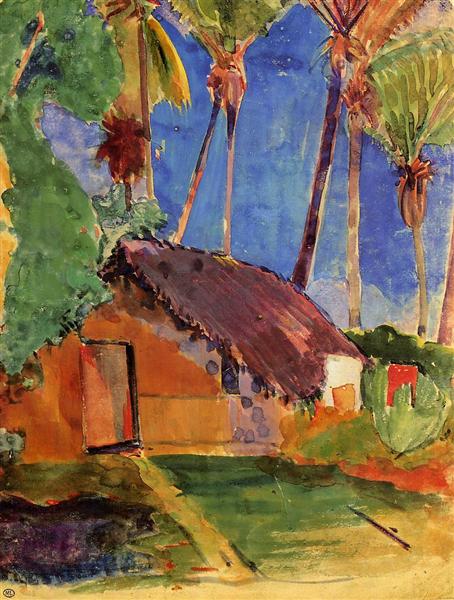説明
Paul Gauguin’s 1894 work “Cottage Under the Coconut Trees” is a visual parable that encapsulates not only the essence of a tropical landscape, but the ethos of an artist in search of a deeper, purer reality, far from the constraints of European life. This piece is emblematic of his period in Tahiti and reflects a complex interrelationship between nature and human architecture, a dialogue that reveals both the harmony and fragility of the environment.
At first glance, the composition greets us with a simple, almost primitive hut that seems to rest under the shade of majestic coconut trees. The structure itself, with its angled palm roofs, emphasizes the simplicity of rural life on a tropical island, while the coconut-laden trees challenge the verticality of the building, providing a sense of both stability and vulnerability. The use of color in this work is particularly captivating; the vibrant greens of the leaves with yellow and ochre tones reveal a lush palette evoking the vitality of the warm climate and the richness of vegetation. This chromatic choice, typical of Gauguin’s work, underlines his characteristic approach to the symbolism of color as a channel for emotion and inner truth.
The use of colour also translates into the way Gauguin structures light and shadow, creating a contrast that brings the cottage and its surroundings to life. Shadows play a crucial role, not only in defining the shape of the house, but in establishing a sense of depth and three-dimensionality that invites the viewer into the painted space. The light is not presented uniformly; instead, it is a dynamic play that highlights both the cottage and the surrounding landscape, leading the viewer to contemplate the balance between the built and the natural.
One notable aspect of “Hut Under the Coconut Trees” is the absence of human figures, which creates a sense of isolation and yet a serenity that is characteristic of unspoiled places. This approach aligns with Gauguin’s desire to capture a primordial, forgotten essence in his art, often associated with native Pacific island life. Through the deliberate omission of characters, Gauguin invites the viewer to meditate on the connection between humans and their environment, suggesting that true life can be found in contemplation of the natural world.
In the context of post-impressionist art, Gauguin revolutionized the way we view color and form, inspiring generations of artists. "Cabin Under the Coconut Trees" resonates with the same concerns that marked his other works from this period, where symbolism and allegory emerge as underlying forces. The work is presented almost as an allegory of the desire to escape to a purer state of existence, which was reflected in his own life, marked by travel and the search for authenticity.
The depiction of the landscape in this work, with its calm and contemplative atmosphere, invites a reflection on human interaction with nature. It is a testament to Gauguin's talent for capturing not only the external gaze of what he sees, but also the internal resonance of what he feels and yearns for. "Cabin Under the Coconut Trees" is not just a visual representation, but an invitation to explore a universe beyond the material, a journey through which each observer can reconnect with his or her own search for meaning in the simplicity of the everyday.
KUADROS ©, a famous painting on your wall.
Hand-made oil painting reproductions, with the quality of professional artists and the distinctive seal of KUADROS ©.
Painting reproduction service with satisfaction guarantee. If you are not completely satisfied with the replica of your painting, we will refund 100% of your money.

